If you’re on the lookout for a selection of fast growing aquatic plants to quickly transform your aquarium into a lush paradise, then you’re in the right place.
Over the years, we’ve grown and helped out 100’s of customers setup planted tanks fast.
Not everybody wants to wait weeks for their aquarium plants, (Anubias comes to mind), to settle in and adapt to the new water parameters before growing new leaves or stems.
Here, we’re all about fast-growing freshwater aquarium plants that are not only easy to grow but also thrive without the need for CO2.
Yes, you heard right! The freshwater plants below will grow fast without any CO2 supplementation.
- Related: 12 Best Carpeting Plans
- Related: Best Stem Plants
- Related: Top 16 Background Plants
- Related: Top 10 Aquarium Foreground Plants
Fast growing & easy to grow aquarium plants, go hand-in-hand, when you’re looking to aquascape a beautiful aquarium.
And the best part? They double a natural hiding spots for your fish to relax and often breed, while also helping to maintain the water quality.
Table of Contents

Understanding Fast Growing Aquarium Plants
Before we dive into 16 fast growing plant options below, let’s talk nutrients. Without adequate nourishment, your plants growth-rate will be stunted.
What’s the key to unlocking a all the essential nutrients and minerals for your plants? Liquid fertilizer, also known as liquid plant food or nutrient supplement.
Pros & Cons of Fast Growing Plants
Pros
- Extra water cleaning / filtering from plants fast growth
- Achieve a mature planted tank look fast
- Can stock more fish per litre/gallon of water
Cons
- Regular Maintenance / Trimming required
- Can outcompete slow growing plants for nutrients
- Requires Regular Fertilisation
Top 16 Fast Growing Freshwater Aquarium Plants
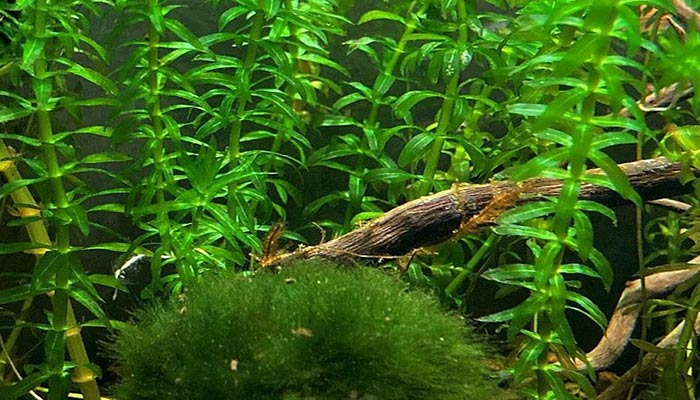
Elodea Densa (Waterweed)
Elodea Densa, also known as Waterweed or Anacharis, is a favourite plant and easily available in fish stores. This fast-growing plant is easy to care for and a fantastic option for both beginners thanks to it’s hardy nature.
- Origin and Appearance: Native to North and South America, Elodea Densa is an aquatic perennial that thrived submerged. Its dark green leaves grow in whorls around its stem, providing a lush, dense feel that can transform your aquarium into an underwater forest.
- Tolerance to Conditions: The plant tolerates a range of conditions, thriving in temperatures from 15°C to 25°C and a pH of 6.5 to 7.5. It’s also adaptable to slightly brackish water.
- Lighting Requirements: Elodea Densa prefers moderate to high light levels but can survive in low light conditions too, but will grow at a slower rate.
- Care and Maintenance: Caring for Elodea Densa involves regular pruning to keep its growth in check and prevent it from overtaking your aquarium. Use aquatic plant scissors to trim the stems, being careful not to uproot the plant.
If you’re looking for a versatile, fast-growing plant that’s easy to maintain, Elodea Densa could be the perfect addition to your aquarium.
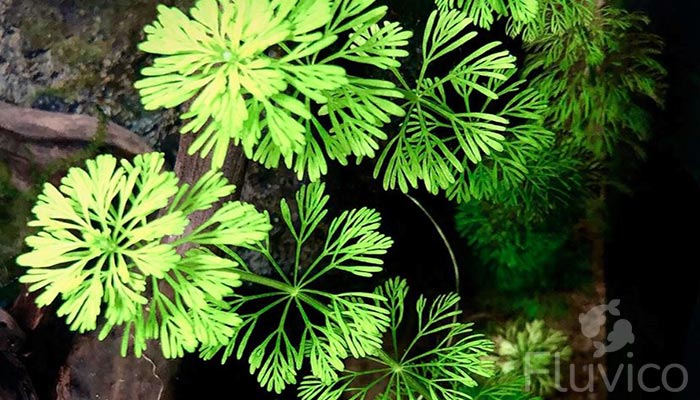
Dwarf Ambulia
Dwarf Ambulia, scientifically known as Limnophila Sessiliflora, is another great option for adding a fast-growing aquatic plant to your tank. This Southeast Asian native is a hit among aquarium hobbyists for its beautiful, feathery leaves and easy-care nature.
You have the option to either plant or float (for extra shade, breeding) the Dwarf Ambulia.
- Description and Habitat: Dwarf Ambulia is a perennial, aquatic plant known for its attractive, feathery, light-green leaves that closely resemble pine needles. These leaves grow in whorls around the stem, creating a beautiful, dense foliage that adds a lush, vibrant feel to your aquarium.
- Tolerance and Requirements: Dwarf Ambulia is a hardy plant that can thrive in a wide range of water conditions. It prefers a temperature range between 22°C to 28°C and can adapt to a pH level of 6.5 to 7.5. It is also capable of surviving in both soft and hard water conditions.
- Lighting Preferences: Dwarf Ambulia enjoys moderate to high light conditions for optimal growth. However, it can also tolerate low light conditions, although its growth might be slower and the leaves less vibrant.
- Benefits: Dwarf Ambulia plays a significant role in improving water quality by absorbing excess nutrients, thereby preventing algae growth. Its dense foliage provides excellent cover and breeding grounds for small fish and invertebrates.
- Care and Maintenance: Dwarf Ambulia is quite easy to care for. It grows rapidly and may need frequent trimming to prevent it from overtaking your aquarium. It’s as simple as snipping the stems and replanting the cuttings, which readily form roots and new plants.
Overall, Dwarf Ambulia is an excellent choice if you’re seeking a fast-growing, easy-to-maintain plant that brings a vibrant, lush feel to your aquarium.

Dwarf Hygro
Dwarf Hygro, or Hygrophila Polysperma, is a popular fast-growing aquatic plant that can bring a fresh, green touch to any aquarium. Its ease of care and adaptability make it an ideal choice for both novice and experienced aquarium enthusiasts.
- Appearance and Habitat: Dwarf Hygro is native to India and Bangladesh. This attractive plant has lanceolate leaves that vary in color from light green to reddish-brown, depending on the lighting conditions. The leaves grow in pairs opposite each other along the stem, giving the plant a bushy appearance.
- Tolerance and Requirements: Known for its adaptability, Dwarf Hygro can thrive in a wide range of water conditions. It prefers temperatures between 20°C to 30°C and can adjust to pH levels of 6.0 to 7.5. This plant is quite hardy and can even tolerate low nutrient levels in the water.
- Lighting Preferences: Dwarf Hygro grows best in moderate to high light conditions. However, it can still survive in low light environments, although its growth rate may be slower, and the colors less vibrant.
- Benefits: Dwarf Hygro plays an essential role in maintaining water quality by absorbing excess nutrients, which helps prevent the growth of unwanted algae. Its dense foliage also offers a safe hiding spot and breeding ground for small fish and invertebrates.
- Care and Maintenance: Caring for Dwarf Hygro is relatively simple. Due to its rapid growth, regular trimming is necessary to keep the plant in check and maintain its bushy appearance. The trimmed cuttings can be replanted in the substrate, where they will readily form roots and grow into new plants.
In summary, if you’re looking for an easy-to-care-for, fast-growing plant that adds a touch of greenery and vitality to your aquarium, Dwarf Hygro is an excellent choice.
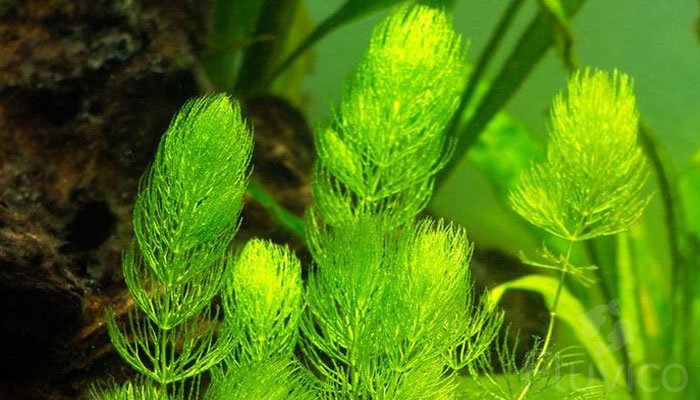
Hornwort
Hornwort, scientifically known as Ceratophyllum demersum, is an incredibly versatile and fast-growing aquatic plant that’s great for beginners and seasoned aquarists alike. Here’s what you need to know:
- Description and Habitat: Hornwort is a cosmopolitan plant, found in all continents except Antarctica. It features thin, needle-like leaves growing from a central stem, which gives it a feather-like appearance. Hornwort does not have roots, so it can be anchored in the substrate or left to float in the aquarium.
- Tolerance and Requirements: Hornwort is a hardy plant that can adapt to a wide range of water conditions. It prefers temperatures between 15°C to 30°C and can tolerate a wide pH range, from 6.0 to 7.5.
- Lighting Preferences: While Hornwort can survive in low-light conditions, it grows best in moderate to high light. In brighter light, it tends to grow more densely, providing more cover for your aquatic pets.
- Benefits: Hornwort is a great addition to any tank due to its ability to improve water quality. It absorbs excess nutrients, including nitrates, thereby reducing algae growth. It also releases chemicals that inhibit the growth of blue-green algae (cyanobacteria). The plant’s dense growth provides a perfect hiding and breeding space for fish and invertebrates.
- Care and Maintenance: Taking care of Hornwort is relatively simple. Due to its fast growth rate, regular trimming is necessary to prevent it from overrunning your aquarium. Cut stems can be left in the water, where they will grow into new plants, or removed altogether.
In conclusion, Hornwort is an excellent choice for aquarists looking for a hardy, fast-growing plant that offers both aesthetic appeal and practical benefits. Its adaptability and easy care make it a perfect choice for almost any freshwater aquarium.
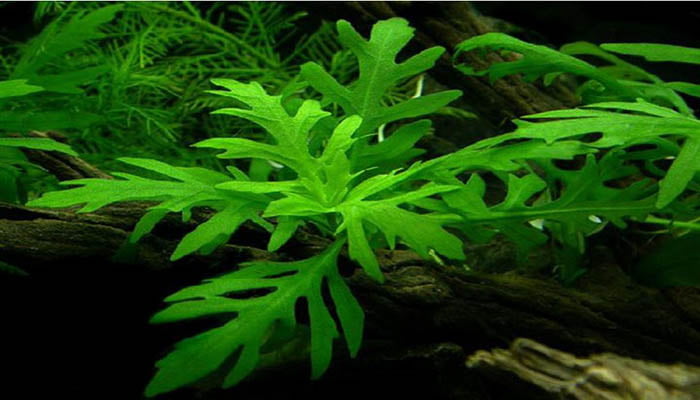
Water Wisteria
Water Wisteria, known scientifically as Hygrophila difformis, is a fast-growing and striking aquatic plant that’s cherished by aquarists for its distinctive, lacy leaves and easy care requirements. Here’s what you should know about this beautiful plant:
- Description and Habitat: Water Wisteria is native to the Indian subcontinent. It’s an attractive plant with bright green, lacy leaves that can add a unique texture and depth to your aquarium.
- Tolerance and Requirements: This plant is highly adaptable and can tolerate a wide range of water conditions. It prefers temperatures between 20°C to 28°C and can handle pH levels from 6.5 to 7.5.
- Lighting Preferences: Water Wisteria does best in medium to high light conditions, which encourage vibrant growth and leaf color. However, it can still survive in low light conditions, although its growth may be slower and leaves less finely detailed.
- Benefits: Water Wisteria is an excellent addition to aquariums because it helps improve water quality. It absorbs excess nutrients, which can help inhibit algae growth. Its dense foliage also provides a great hiding and breeding place for fish and invertebrates.
- Care and Maintenance: Taking care of Water Wisteria involves regular pruning to maintain its shape and size, as it can grow quite quickly. The cut stems can be replanted in the substrate, where they will readily form roots and new plants.
In conclusion, if you’re looking for a fast-growing, easy-to-care-for plant that adds a unique aesthetic to your aquarium, Water Wisteria is a fantastic choice.

Rotala Rotundifolia
Rotala Rotundifolia is an elegant, fast-growing aquatic plant that’s cherished for its beautiful, delicate appearance and the pop of color it adds to aquariums. Here’s what you need to know about this stunning plant:
- Description and Habitat: Rotala Rotundifolia, originally from Southeast Asia, is known for its slender leaves and stems, which turn a beautiful reddish color when provided with ample light. It can be planted in the mid-ground or background of an aquarium, where it adds depth and a burst of color.
- Tolerance and Requirements: This plant prefers warmer water temperatures, ranging from 22°C to 28°C, and a pH level between 6.0 to 7.5. While it can tolerate a range of water conditions, it thrives best in soft, slightly acidic water.
- Lighting Preferences: Rotala Rotundifolia needs moderate to high lighting to grow well and achieve its best coloration. However, it can survive in low-light conditions, although its growth may be slower and the colors less vibrant.
- Benefits: Rotala Rotundifolia is not just beautiful but also beneficial for the aquarium ecosystem. It helps improve water quality by absorbing excess nutrients, thus preventing unwanted algae growth. Its dense growth also provides shelter for small aquatic creatures.
- Care and Maintenance: Caring for Rotala Rotundifolia involves regular trimming to maintain its bushy growth and prevent it from growing too tall. The trimmed stems can be replanted into the substrate, where they’ll quickly develop roots and grow into new plants.
In conclusion, Rotala Rotundifolia is an excellent choice for aquarium enthusiasts looking for a fast-growing, colorful plant that’s relatively easy to care for. Its vibrant appearance and growth habits make it a standout addition to any freshwater aquarium.
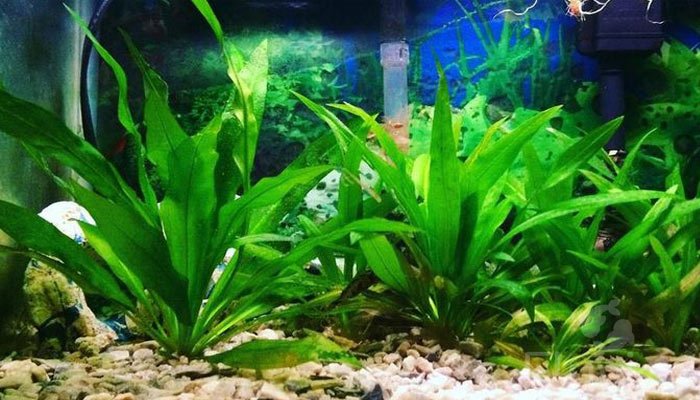
Amazon Sword
The Amazon Sword, known scientifically as Echinodorus Bleheri, is a popular choice among aquarium enthusiasts due to its impressive size, easy care, and stately appearance. Here’s all you need to know about this majestic plant:
- Description and Habitat: The Amazon Sword is native to Central and South America. Its large, broad leaves make it an ideal focal point for any aquarium, providing a lush, green backdrop.
- Tolerance and Requirements: This plant is very hardy and adaptable, tolerating a wide range of water conditions. It prefers temperatures between 22°C to 28°C and can handle pH levels from 6.0 to 7.5.
- Lighting Preferences: Amazon Sword thrives in moderate to high light conditions. However, it can tolerate low light conditions too, although its growth may be slower.
- Benefits: Amazon Sword is beneficial for the aquarium ecosystem as it helps improve water quality by absorbing excess nutrients, thus controlling algae growth. Its large leaves also provide a great hiding and breeding place for fish and invertebrates.
- Care and Maintenance: Care for Amazon Sword involves regular pruning to remove dead or yellowing leaves. This plant has a strong root system, so a nutrient-rich substrate is essential for its health and growth.
In conclusion, the Amazon Sword is an excellent choice for aquarists looking for a large, easy-to-care-for plant that adds a striking visual impact to any aquarium. Its adaptability and benefits to the aquarium ecosystem make it a valuable addition to any freshwater setup.

Duckweed
Duckweed, known scientifically as Lemna minor, is a fast-growing aquatic plant that can quickly cover the surface of your aquarium. Despite its small size, it brings several benefits to the aquarium ecosystem. Here’s what you need to know about Duckweed:
- Description and Habitat: Duckweed is a small, free-floating plant native to most parts of the world. Its tiny green leaves float on the water surface, forming a dense carpet that gives your aquarium a natural, pond-like look.
- Tolerance and Requirements: Duckweed is incredibly hardy and can thrive in a wide range of water conditions. It prefers temperatures between 15°C to 30°C and a pH range from 5.0 to 9.0.
- Lighting Preferences: Duckweed can grow under low to high light conditions. However, it grows fastest in higher light conditions.
- Benefits: Duckweed is beneficial for your aquarium as it helps improve water quality by absorbing excess nutrients, thus reducing algae growth. It also provides a food source for some species of fish and reduces evaporation by covering the water surface.
- Care and Maintenance: Caring for Duckweed involves regular thinning to prevent it from covering the entire water surface, which could block light to other plants. Simply scoop out excess plants with a net to maintain a healthy balance in your aquarium.
In conclusion, if you’re looking for a plant that’s easy to care for, improves your aquarium’s water quality, and gives your setup a unique, natural look, Duckweed could be a great choice. Just be prepared to do some regular maintenance to keep its rapid growth in check!
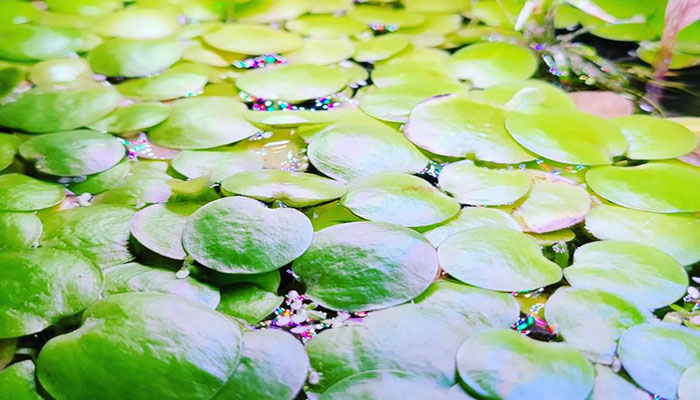
Amazon Frogbit
Amazon Frogbit, also known as Limnobium laevigatum, is a popular, fast-growing floating plant that adds a beautiful, natural look to your aquarium. Here are the key points to know about this intriguing plant:
- Description and Habitat: Amazon Frogbit is native to Central and South America. It features smooth, round leaves that float on the water’s surface, creating a pleasing aesthetic and providing shade for your aquatic creatures.
- Tolerance and Requirements: This plant is known for its adaptability and can tolerate a range of water conditions. It prefers temperatures between 18°C to 30°C and pH levels from 6.0 to 7.5.
- Lighting Preferences: Amazon Frogbit does well under low to high light conditions. However, under higher light, it can grow more quickly and its leaves can achieve a larger size.
- Benefits: Amazon Frogbit aids in improving water quality by absorbing excess nutrients, helping to control algae growth. Its roots also provide a great hiding and breeding place for fish and invertebrates, enhancing your tank’s biodiversity.
- Care and Maintenance: Caring for Amazon Frogbit involves regular removal of older leaves and thinning out the plant to prevent it from blocking light to other plants in the aquarium. Be cautious when changing water, as Frogbit can be sensitive to splashing.
In conclusion, Amazon Frogbit can be an excellent addition to your aquarium if you’re looking for a fast-growing, low-maintenance plant that offers multiple benefits to your aquatic environment. Its lush, floating leaves provide a natural and calming aesthetic to your setup.
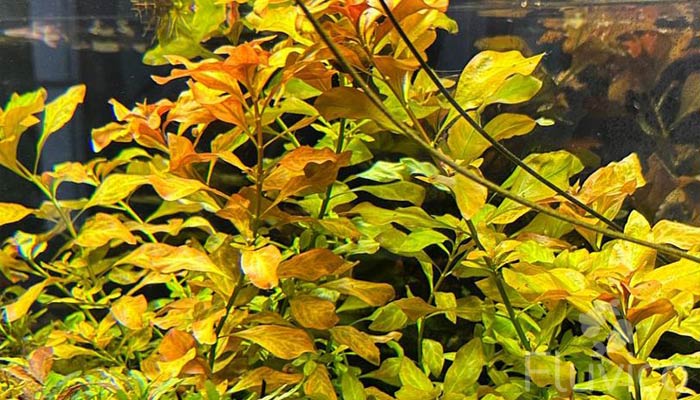
Ludwigia Repens
Ludwigia Repens, also known as Red Ludwigia, is a striking, fast-growing aquatic plant that’s valued for its vibrant color and easy care. Here’s what you need to know about this appealing plant:
- Description and Habitat: Ludwigia Repens is a popular choice in freshwater aquariums. Native to North and South America, this stem plant boasts a beautiful range of colors from green to deep red, adding a splash of color to any aquarium.
- Tolerance and Requirements: Ludwigia Repens is an adaptable plant that can thrive in a variety of water conditions. It prefers warmer water temperatures, between 20°C to 28°C, and a pH range of 5.0 to 8.0.
- Lighting Preferences: Ludwigia Repens grows best under moderate to high light conditions. Under high light, the plant can achieve its most intense red coloration.
- Benefits: Ludwigia Repens is not just a colorful plant but also beneficial for the aquarium ecosystem. It absorbs excess nutrients from the water, improving water quality and helping to control algae. Its dense growth also provides cover for fish and invertebrates.
- Care and Maintenance: Caring for Ludwigia Repens involves regular trimming to encourage bushier growth and prevent it from growing too tall. Cut stems can be replanted into the substrate to propagate new plants.
In conclusion, Ludwigia Repens is a great choice for anyone wanting to add a fast-growing, colorful, and easy-to-care-for plant to their aquarium. Its striking appearance and simple requirements make it a favorite among aquarists.
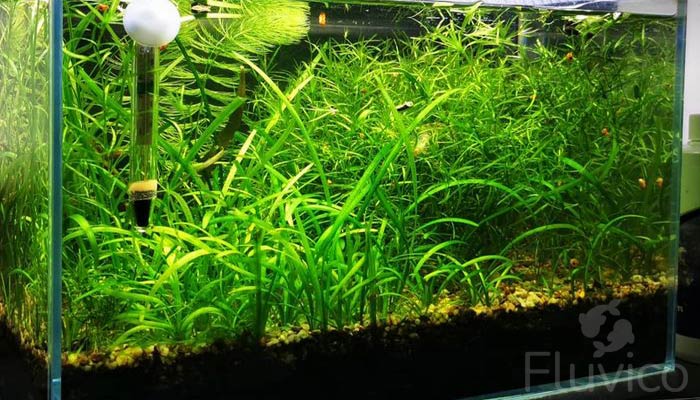
Dwarf Sagittaria
Dwarf Sagittaria, scientifically known as Sagittaria subulata, is a fast-growing aquatic plant that makes an excellent addition to any aquarium, particularly as a foreground or midground plant. Here’s what you need to know about Dwarf Sagittaria:
- Description and Habitat: Native to the Americas, Dwarf Sagittaria is characterized by its grass-like appearance. It features thin, arrow-shaped leaves that grow upwards, creating a dense carpet that adds depth and texture to your aquarium.
- Tolerance and Requirements: Dwarf Sagittaria is quite hardy and can tolerate a range of water conditions. It prefers temperatures between 22°C to 28°C and a pH range of 6.0 to 8.0.
- Lighting Preferences: This plant grows best in moderate to high light conditions. However, it can survive in low light, although the growth will be slower and the leaves will grow taller as they reach for the light.
- Benefits: Dwarf Sagittaria is beneficial for the aquarium ecosystem as it helps control algae by consuming excess nutrients. It also provides a safe haven for small aquatic creatures, making it an excellent choice for community tanks.
- Care and Maintenance: Caring for Dwarf Sagittaria involves regular trimming to keep its growth in check and maintain the desired carpet-like appearance. Propagation is simple, as this plant naturally sends out runners to produce new plants.
In conclusion, Dwarf Sagittaria is an excellent choice for aquarists looking for a fast-growing, easy-to-care-for plant that can create a beautiful, natural-looking carpet in their aquarium. Its versatility and benefits to the aquarium ecosystem make it a valuable addition to any freshwater setup.
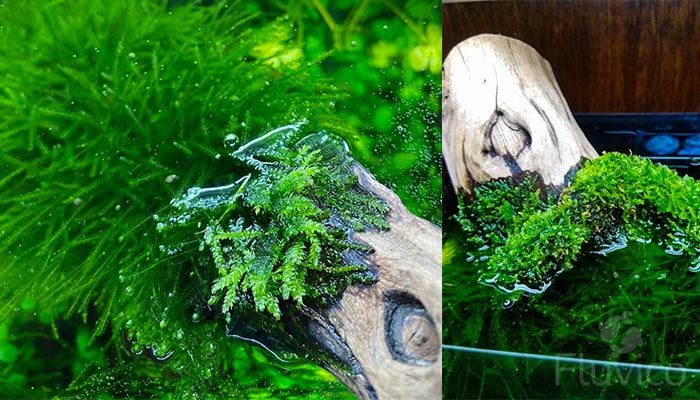
Java Moss
Java Moss, known scientifically as Vesicularia dubyana, is a favorite among aquarium hobbyists for its hardiness, versatility, and fast growth. Here’s everything you need to know about this popular aquatic plant:
- Description and Habitat: Native to Southeast Asia, Java Moss is a delicate moss that attaches itself to rocks, roots, and driftwood. Its tangled green threads can form dense, lush mats that add a touch of nature to your aquarium.
- Tolerance and Requirements: Java Moss is exceptionally hardy and can thrive in a broad range of water conditions. It prefers temperatures between 15°C to 30°C and a pH range from 5.0 to 8.0.
- Lighting Preferences: Java Moss can grow under low to high light conditions. However, more light will encourage faster, denser growth.
- Benefits: Java Moss is beneficial for the aquarium ecosystem as it helps maintain water quality by absorbing excess nutrients, thereby controlling algae growth. It also provides an excellent breeding ground and shelter for fish and small invertebrates.
- Care and Maintenance: Java Moss requires minimal care. Occasional trimming will keep its growth under control and maintain your desired look. Be sure to remove any excess trimmings to prevent decay and potential water quality issues.
In conclusion, if you’re looking for an easy-to-maintain, fast-growing aquatic plant that offers multiple benefits to your aquarium ecosystem, Java Moss could be the perfect choice. It’s ideal for beginners and seasoned aquarists alike, thanks to its low maintenance needs and adaptable nature.
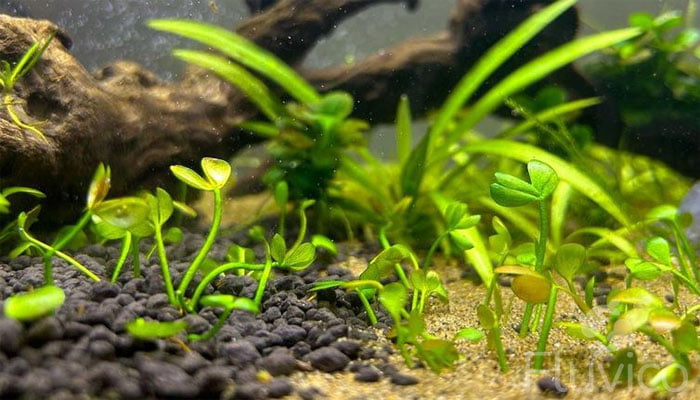
Marsilea Hirsuta
Marsilea Hirsuta is a fast-growing aquatic fern known for its unique clover-like appearance and easy care requirements. Here’s everything you need to know about this intriguing plant:
- Description and Habitat: Native to Australia, Marsilea Hirsuta is an aquatic fern characterized by small, clover-like leaves. When submerged in water, the plant can develop different leaf shapes, making it a fascinating addition to any aquarium.
- Tolerance and Requirements: Marsilea Hirsuta is a hardy plant that can adapt to a wide range of water conditions. It prefers temperatures between 22°C to 28°C and a pH range of 6.0 to 7.5.
- Lighting Preferences: Marsilea Hirsuta can grow under low to high light conditions. However, it tends to grow more slowly under low light, developing taller stems as it reaches for more light.
- Benefits: Besides adding beauty to your aquarium, Marsilea Hirsuta is beneficial for the aquatic ecosystem. It helps to control algae by consuming excess nutrients and provides shelter for small aquatic creatures.
- Care and Maintenance: Caring for Marsilea Hirsuta involves regular trimming to control its height and spread. It propagates through runners, which can be cut and replanted for more growth.
In conclusion, Marsilea Hirsuta is an excellent choice if you’re looking for a fast-growing, low-maintenance plant that adds a unique touch to your aquarium. Its adaptability and benefits to the aquatic ecosystem make it a valuable addition to any freshwater setup.
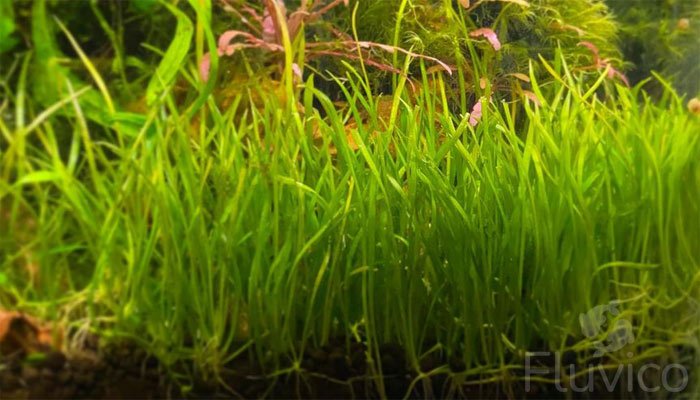
Micro Sword
Micro Sword, also known as Lilaeopsis brasiliensis, is a popular choice for aquarium hobbyists seeking a fast-growing, carpet-forming plant. Here’s everything you need to know about this charming aquatic plant:
- Description and Habitat: Native to South America, Micro Sword is a grass-like plant that grows low, making it an excellent foreground choice. Its thin, bright green leaves can create a lush carpet effect, resembling a miniature underwater lawn.
- Tolerance and Requirements: Micro Sword is a hardy plant that can adapt to a variety of water conditions. It prefers temperatures between 20°C to 28°C and a pH range of 6.5 to 7.5.
- Lighting Preferences: Micro Sword thrives under high light conditions, which stimulate faster and denser growth. However, it can survive under moderate lighting, albeit at a slower growth rate.
- Benefits: In addition to its aesthetic appeal, Micro Sword provides practical benefits by absorbing excess nutrients from the water, thus helping to control algae. It also provides a hiding place for small fish and invertebrates.
- Care and Maintenance: Regular trimming is required to maintain the carpet-like appearance of Micro Sword. Over time, it will spread through runners, which can be trimmed and replanted for propagation.
In conclusion, if you’re looking for a fast-growing, carpet-forming plant that’s relatively easy to care for, Micro Sword could be an excellent addition to your aquarium. Its unique appearance and benefits to the aquarium ecosystem make it a valuable choice for both novice and experienced aquarists.

Brazilian Pennywort
Brazilian Pennywort, scientifically known as Hydrocotyle leucocephala, is a versatile and fast-growing plant that brings a touch of the tropical to your aquarium. Here’s what you need to know about this popular plant:
- Description and Habitat: Native to wetlands in South and Central America, Brazilian Pennywort is recognizable by its bright green, round leaves on trailing stems. It can grow either fully submerged or partially out of the water, adding a unique element to your tank.
- Tolerance and Requirements: Brazilian Pennywort is a hardy plant that can tolerate a wide range of water conditions. It prefers temperatures between 20°C to 28°C and a pH range of 6.0 to 7.5.
- Lighting Preferences: This plant grows well in low to high light conditions. More light will encourage faster growth, but be careful, as too much light can lead to algae issues.
- Benefits: Brazilian Pennywort is beneficial to the aquarium ecosystem as it absorbs excess nutrients, helping to control algae. It also provides shelter and breeding grounds for fish and invertebrates.
- Care and Maintenance: Brazilian Pennywort requires regular trimming to control its growth and shape. It is also easy to propagate – simply cut a stem and replant it in the substrate.
In conclusion, Brazilian Pennywort is an excellent choice for aquarists looking for a fast-growing, easy-to-care-for plant that can add a touch of the tropical to their aquarium. Its versatility and benefits to the aquarium ecosystem make it a valuable addition to any freshwater setup.
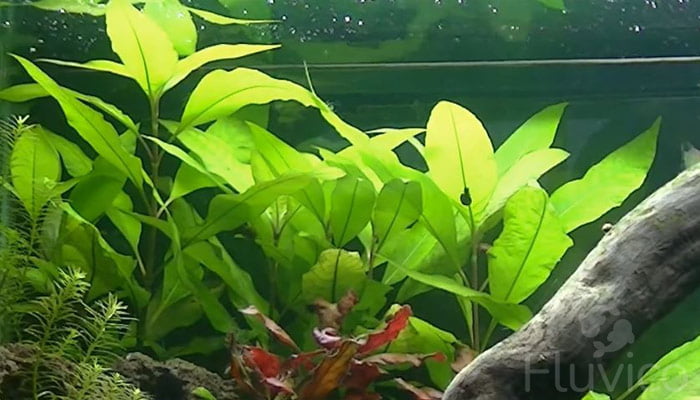
Giant Hygro
Giant Hygro, or Hygrophila corymbosa, is an appealing, fast-growing plant that can be a stunning addition to your aquarium. Here’s what you need to know about this popular plant:
- Description and Habitat: Native to South East Asia, Giant Hygro is characterized by its tall stems and broad, bright green leaves. In the right conditions, it can reach impressive heights, making it an excellent background plant for larger aquariums.
- Tolerance and Requirements: This robust plant can adapt to a variety of water conditions. It prefers temperatures between 22°C to 28°C and a pH range of 6.0 to 7.5.
- Lighting Preferences: Giant Hygro thrives in medium to high light conditions. However, it can survive in low light, although its growth may be slower.
- Benefits: Apart from its aesthetic appeal, Giant Hygro plays a practical role in the aquarium by absorbing excess nutrients, thereby helping to control algae. It also provides shelter and breeding grounds for fish and invertebrates.
- Care and Maintenance: Caring for Giant Hygro involves regular trimming to control its height and promote bushier growth. It’s also easy to propagate – simply plant the cuttings in the substrate.
In conclusion, if you’re looking for a tall, fast-growing plant that’s relatively easy to care for, Giant Hygro could be an excellent addition to your aquarium. Its striking appearance and benefits to the aquarium ecosystem make it a valuable choice for both novice and experienced aquarists.
Plant Care: Ensuring Your Aquarium Plants Grow Fast
In order to ensure that your aquarium plants grow fast and healthy, it’s crucial to provide them with the right conditions and care. This section will delve into the essential elements that aquarium plants need for rapid growth.
What Do Plants Need to Grow Faster?
Plants, just like all living organisms, require certain conditions and nutrients for optimal growth. Here are the key factors that affect the growth rate of your aquarium plants:
- Light: Light is the primary energy source for plants. It allows them to photosynthesize, converting light energy into chemical energy for growth. Ensure your aquarium has sufficient lighting that matches the needs of your specific plants.
- Nutrients: Plants require a variety of nutrients to grow. These include macronutrients like nitrogen, phosphorus, and potassium, as well as micronutrients such as iron, manganese, and zinc. You can provide these nutrients through a quality substrate or by adding liquid fertilizer.
- CO2: Carbon dioxide is critical for photosynthesis. Some plants require more CO2 than others. While many aquarium plants can survive with the amount of CO2 naturally present in the water, adding a CO2 system can significantly boost their growth.
- Water Parameters: The temperature, pH, and hardness of your aquarium water can significantly impact plant growth. Each plant species has its own preferred water conditions, so it’s important to match your plants to your water or adjust your water to suit your plants.
- Trimming and Pruning: Regular trimming promotes bushier growth and prevents fast-growing plants from taking over the aquarium. It also helps to remove any unhealthy parts of the plant, enabling it to focus its energy on new growth.
By understanding and providing what your plants need, you can enjoy a lush, vibrant aquarium filled with healthy, fast-growing plants.

Products That Make Aquarium Plant Care Easier
Products That Make Aquarium Plant Care Easier
Looking after your aquarium plants can be a breeze with the right tools and products. Here are some of my favourite items that can help you maintain a vibrant and healthy aquarium:
- Aquarium Plant Fertilizer: Nutrients are crucial for plant growth, and a good aquarium plant fertilizer can provide all the essential nutrients your plants need. Products like Seachem Flourish or API Leaf Zone are popular choices.
- CO2 System: For plants that require more CO2, a CO2 system can be a great investment. The Fluval Pressurized CO2 Kit is user-friendly and ideal for small to medium-sized aquariums.
- Aquarium Lights: Adequate lighting is key for photosynthesis. Consider a programmable LED light, like the NICREW ClassicLED Plus, which offers full-spectrum light and a customizable schedule.
- Aquarium Scissors: A pair of curved aquarium scissors, like the JARDLI Professional Aquascaping Tools, are essential for trimming and maintaining your plants. They allow you to reach into the tank and cut with precision.
- Water Test Kit: Regularly testing your water parameters can help you spot any potential issues early. The API Master Test Kit is a reliable choice that can test for pH, ammonia, nitrite, and nitrate levels.
- Plant Substrate: A nutrient-rich substrate, like Fluval Plant and Shrimp Stratum or CaribSea Eco-Complete, provides a solid foundation for your plants to root and draw nutrients from.
Remember, the key to fast-growing, healthy aquarium plants is not just about having the right products but using them appropriately. Always follow the instructions and adjust as necessary for your specific aquarium conditions and plant species.
Conclusion
Creating a thriving underwater ecosystem can be a rewarding experience. Choosing the right plants, providing them with the necessary care, and using suitable products to simplify the process are all integral parts of this journey.
The Importance of Fast Growing Aquarium Plants
Fast-growing aquarium plants are more than just pretty greenery. They’re the silent heroes of your aquatic ecosystem. They create a lively environment for your fish, improve water quality, and can turn your aquarium into an underwater masterpiece in no time.
Imagine this: It’s been a long day, and you finally get a moment to sit down. As you glance at your aquarium, you see your plants have grown noticeably, making your tank look more vibrant than ever. Now, isn’t that instant gratification at its best?
These rapid growers are not only an easy way to fill your aquarium quickly but they’re also typically hardy and adaptable, making them perfect for both beginners and seasoned hobbyists.
But remember, balance is key. Your aquarium is a delicate ecosystem, and choosing a variety of plant species that suit your specific conditions can make all the difference.
So, are you ready to dive in? With the right plants and care, you’ll not just be growing an aquarium, but an underwater sanctuary for your aquatic friends. Now, who can resist that? Don’t wait. Transform your aquarium into a lush, green wonderland today!
More Reading

15 Types of Cryptocoryne: Which is Best For Your Aquarium Setup?

16 Awesome Low Light Aquarium Plants (Mosses, Ferns & Stem Plants)


18 Types of Aquarium Moss: Photos, Care, Propagation & Growth Guide

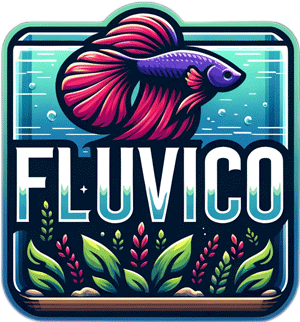
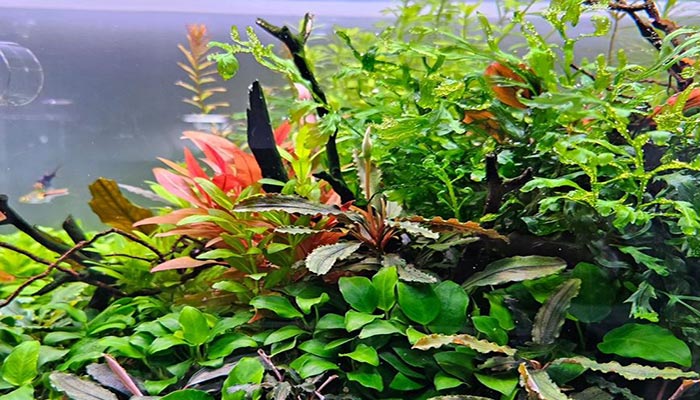
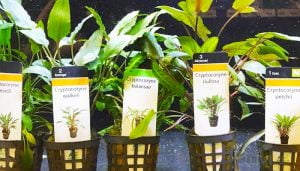
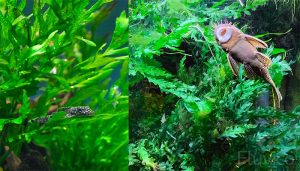
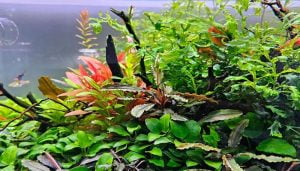

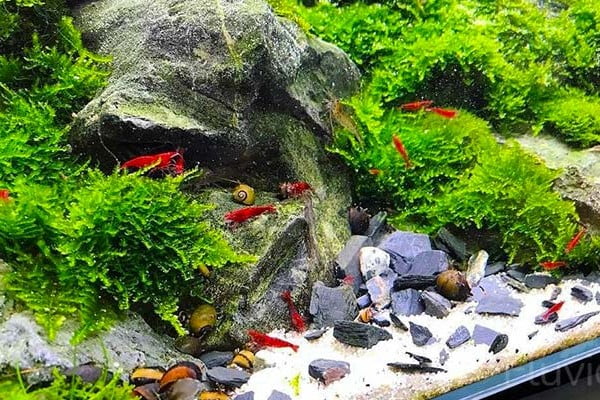
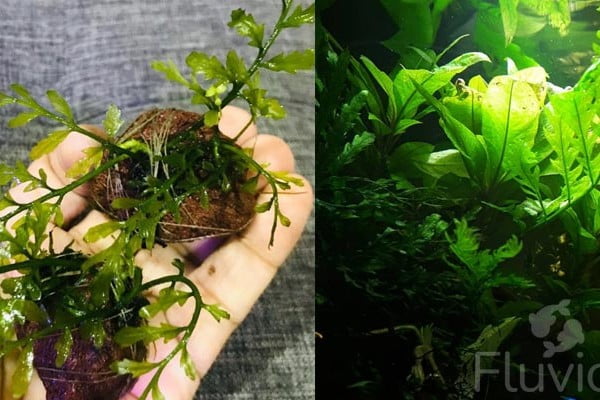
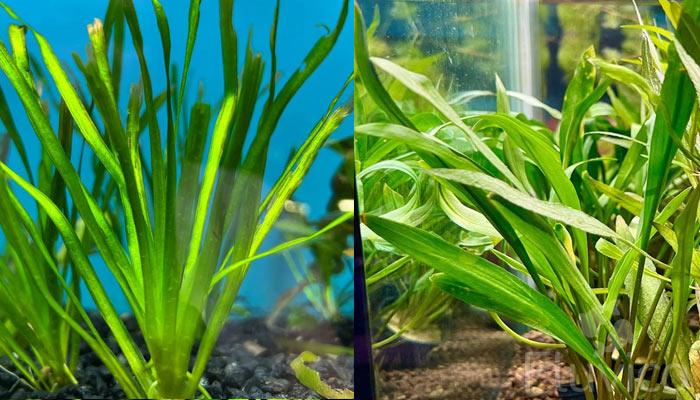
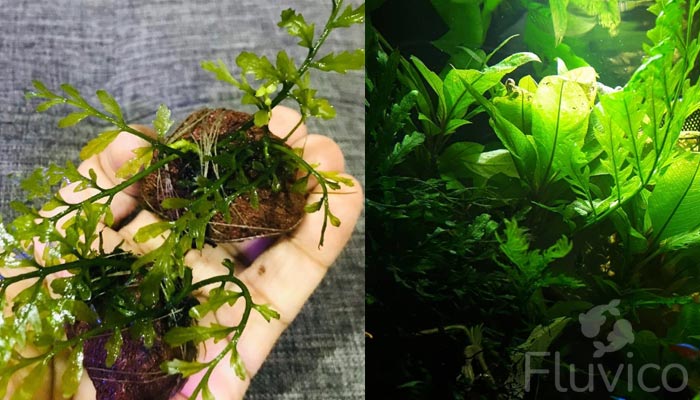

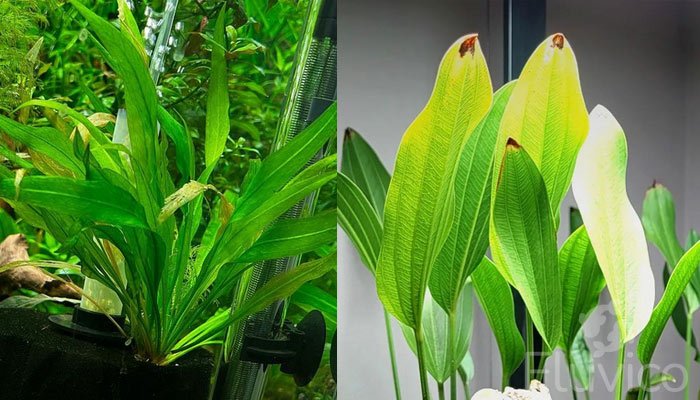
Hope you enjoyed our Fast Growing Freshwater List! As always if you have any questions or tips of your own, comment below.
All the best,
Charlie